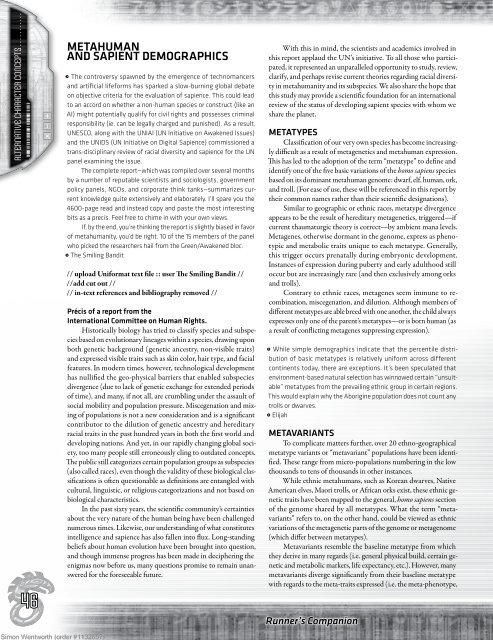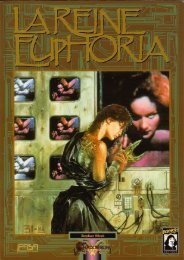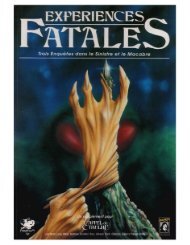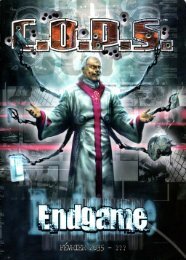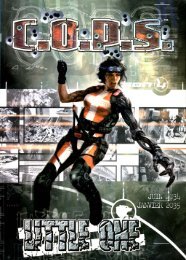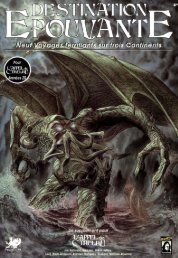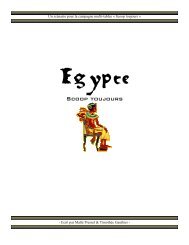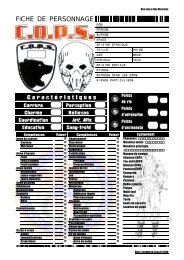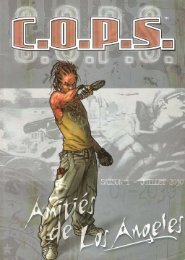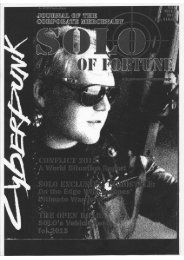Runner's Companion.pdf - Free
Runner's Companion.pdf - Free
Runner's Companion.pdf - Free
- No tags were found...
You also want an ePaper? Increase the reach of your titles
YUMPU automatically turns print PDFs into web optimized ePapers that Google loves.
Simon Wentworth (order #1132857) 9alternative character concepts . . . . . . . . . . .46MetahumanAND SAPIENT Demographics> The controversy spawned by the emergence of technomancersand artificial lifeforms has sparked a slow-burning global debateon objective criteria for the evaluation of sapience. This could leadto an accord on whether a non-human species or construct (like anAI) might potentially qualify for civil rights and possesses criminalresponsibility (ie. can be legally charged and punished). As a result,UNESCO, along with the UNIAI (UN Initiative on Awakened Issues)and the UNIDS (UN Initiative on Digital Sapience) commissioned atrans-disciplinary review of racial diversity and sapience for the UNpanel examining the issue.The complete report—which was compiled over several monthsby a number of reputable scientists and sociologists, governmentpolicy panels, NGOs, and corporate think tanks—summarizes currentknowledge quite extensively and elaborately. I’ll spare you the4600-page read and instead copy and paste the most interestingbits as a precís. Feel free to chime in with your own views.If, by the end, you’re thinking the report is slightly biased in favorof metahumanity, you’d be right. 10 of the 15 members of the panelwho picked the researchers hail from the Green/Awakened bloc.> The Smiling Bandit// upload Uniformat text file :: user The Smiling Bandit ////add cut out //// in-text references and bibliography removed //Précis of a report from theInternational Committee on Human Rights.Historically biology has tried to classify species and subspeciesbased on evolutionary lineages within a species, drawing uponboth genetic background (genetic ancestry, non-visible traits)and expressed visible traits such as skin color, hair type, and facialfeatures. In modern times, however, technological developmenthas nullified the geo-physical barriers that enabled subspeciesdivergence (due to lack of genetic exchange for extended periodsof time), and many, if not all, are crumbling under the assault ofsocial mobility and population pressure. Miscegenation and mixingof populations is not a new consideration and is a significantcontributor to the dilution of genetic ancestry and hereditaryracial traits in the past hundred years in both the first world anddeveloping nations. And yet, in our rapidly changing global society,too many people still erroneously cling to outdated concepts.The public still categorizes certain population groups as subspecies(also called races), even though the validity of these biological classificationsis often questionable as definitions are entangled withcultural, linguistic, or religious categorizations and not based onbiological characteristics.In the past sixty years, the scientific community’s certaintiesabout the very nature of the human being have been challengednumerous times. Likewise, our understanding of what constitutesintelligence and sapience has also fallen into flux. Long-standingbeliefs about human evolution have been brought into question,and though immense progress has been made in deciphering theenigmas now before us, many questions promise to remain unansweredfor the foreseeable future.With this in mind, the scientists and academics involved inthis report applaud the UN’s initiative. To all those who participated,it represented an unparalleled opportunity to study, review,clarify, and perhaps revise current theories regarding racial diversityin metahumanity and its subspecies. We also share the hope thatthis study may provide a scientific foundation for an internationalreview of the status of developing sapient species with whom weshare the planet.MetatypesClassification of our very own species has become increasinglydifficult as a result of metagenetics and metahuman expression.This has led to the adoption of the term “metatype” to define andidentify one of the five basic variations of the homo sapiens speciesbased on its dominant metahuman genome: dwarf, elf, human, ork,and troll. (For ease of use, these will be referenced in this report bytheir common names rather than their scientific designations).Similar to geographic or ethnic races, metatype divergenceappears to be the result of hereditary metagenetics, triggered—ifcurrent thaumaturgic theory is correct—by ambient mana levels.Metagenes, otherwise dormant in the genome, express as phenotypicand metabolic traits unique to each metatype. Generally,this trigger occurs prenatally during embryonic development.Instances of expression during puberty and early adulthood stilloccur but are increasingly rare (and then exclusively among orksand trolls).Contrary to ethnic races, metagenes seem immune to recombination,miscegenation, and dilution. Although members ofdifferent metatypes are able breed with one another, the child alwaysexpresses only one of the parent’s metatypes—or is born human (asa result of conflicting metagenes suppressing expression).> While simple demographics indicate that the percentile distributionof basic metatypes is relatively uniform across differentcontinents today, there are exceptions. It’s been speculated thatenvironment-based natural selection has winnowed certain “unsuitable”metatypes from the prevailing ethnic group in certain regions.This would explain why the Aborigine population does not count anytrolls or dwarves.> ElijahMetavariantsTo complicate matters further, over 20 ethno-geographicalmetatype variants or “metavariant” populations have been identified.These range from micro-populations numbering in the lowthousands to tens of thousands in other instances.While ethnic metahumans, such as Korean dwarves, NativeAmerican elves, Maori trolls, or African orks exist, these ethnic genetictraits have been mapped to the general, homo sapiens sectionof the genome shared by all metatypes. What the term “metavariants”refers to, on the other hand, could be viewed as ethnicvariations of the metagenetic parts of the genome or metagenome(which differ between metatypes).Metavariants resemble the baseline metatype from whichthey derive in many regards (i.e. general physical build, certain geneticand metabolic markers, life expectancy, etc.). However, manymetavariants diverge significantly from their baseline metatypewith regards to the meta-traits expressed (i.e. the meta-phenotype,Runner’s <strong>Companion</strong>


